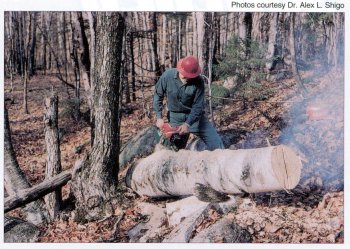

Dissections of thousands of trees with a chain saw started a New Tree Biology in 1959.

Dissections showed that there were highly ordered patterns of discolored and decayed wood associated with wounds and branch stubs.

Patterns of discoloration and decay in many trees could not be explained by the heartrot concept. Heartwood in this white oak was sound in the center yet distinct columns of decay were associated with the wounds. The decay did not spread at-will in the heartwood.
Wood;
is it living or dead in growing trees? Yes! Another type of duality that
started new concepts dealing with trees and their associates. A New Tree
Biology started to develop.
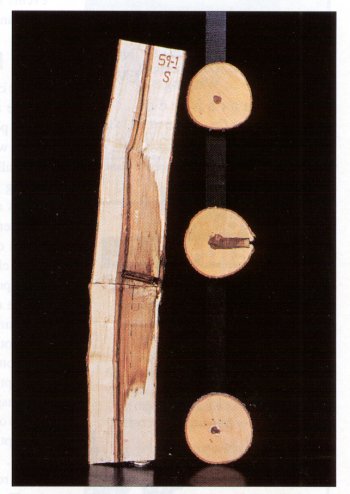
Thousands of trees were treated and later dissected to map the spread of infections. This dissected sugar maple shows the discolored wood associated with the experimental drill wound.
Compartmentalization
is under moderate to strong genetic control. The ability of microorganisms
to compete successfully with others and to spread within the compartments
is also under genetic control.
These concepts help explain long-term survival of trees and their associates. Some of the associates benefit the tree while others act against the tree. However, while events are happening, the tree as a generating system is growing new parts in new spatial positions. In this sense, the tree does not heal or restore injured and infected tissues. While all of these events are taking place, time is going by. The events explain the long-term survival of trees and their associates.
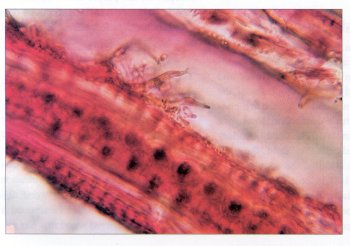
Hundreds of thousands of isolations for microorganisms from sound and infected wood showed that bacteria and non-decay causing fungi were usually the first organisms to invade wood through wounds and branch stubs. Here is a non-decay causing fungus, Phialophora mellinii, in a vessel in discolored wood in a red maple.
One
concept that has blocked progress with understanding tree defense is the
heartrot concept. Along with the concept has come "heartrot fungi." The
heartrot concept is based on wood as a dead, non- responsive substance.
The heartrot concept is a wood decomposition concept. The concept states
that wounds expose heartwood, which is dead wood, and the wood-rotting
"heartrot fungi" then infect the dead wood and grow at will, eventually
producing fruiting structures on the wound face. If the wound does not
expose heartwood, then the injured wood soon becomes "wound heartwood,"
"pathological heartwood," or "precocious heartwood." This concept is still
alive and very well in many textbooks and in the classrooms of the world.
A major problem is the confusion about wood. It is seldom defined.
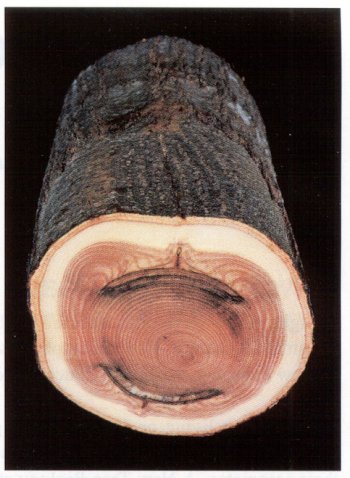
Wounding
experiments on heartwood- forming trees, such as the red oak shown here,
helped to prove further that infections spread in highly ordered and predictable
patterns.
The
symplast is concentrated in a circumferencial zone between the wood and
bark called the cambial zone, and an outer bark circumferencial zone called
the phellogen and in radial bundles called meristematic points. This symplast
concept is essential to an understanding of compartmentalization. Once
the symplast concept is understood, then many parts of the compartmentalization
concept fall into place. Just as you cannot have regenerating terms for
a generating system, you cannot have dead wood terms for an organ that
contains living cells. The easiest way to see the extent of the symplast
is to pour a solution containing iodine (I2-KI) over a freshly cut wood
section. The iodine stains starch grains purple, and except for a few rare
exceptions, the purple dots will only be seen in living cells. (The exceptions
deal with starch grains left behind in cells that died quickly.)
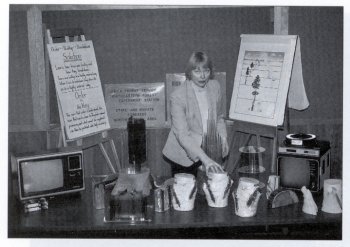
Sharon Ossenbruggen (now deceased) developed many teaching programs that used a wide variety of models and other materials designed to help clarify new concepts.
In nature, there are no absolutes. Strong defense and protection mean that there will be longer time periods before decomposition. Boundaries resist, not stop, infections. Strong tree defense re- actions favor longer time periods, but eventually all living matter will be reduced to its primary parts, which will be reused, or recycled, for new life. Some tree species, or even protection properties. These features are under genetic control. A major protection boundary that determines the longevity of many trees is the protection zone at the base of branches. All trees have branches and as some branches die or are mechanically removed, the openings are infection courts for wood-inhabiting microorganisms. The tree species that have the strongest branch-protection boundaries are those that usually live the longest.
As
microorganisms invade trunks by way of branch openings, the tree may eventually compartmentalize
the infecting microorganisms. However, over time as the trunk wood walls
off more symplast, the space for storage of energy reserves is also walled
off. This is a major way root-rotting fungi slowly kill trees. The tree keeps losing space for storage, and as energy
storage materials decrease, so does the capacity for defense.
The compartmentalization concept includes more than the tree; it also includes organisms associated with the tree. If trees had absolute defense and protection, wood would never decay. But, it does.
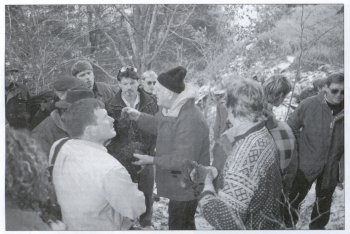
Many workshops were
conducted to help arborists learn about the new concepts by touching all parts
of the tree, inside and outside. Here participants are getting ready
to dig roots and touch mycorrhizae under snow-covered soils.
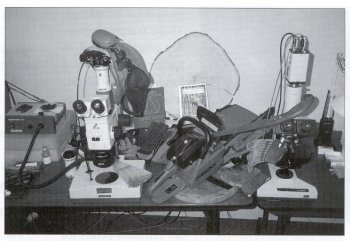
A
New Tree Biology brings together the microscope and the chain saw. The
concepts that have developed over the last 40 years have been made possible
because of the hard work done by many people. There is still a long way
to go.
Such
a system has long-term, but not absolute, survival. As any system increases
in mass, the energy to maintain order in the system increases exponentially.
However, the tree has "a way" to minimize this threat to survival by shedding
parts. The tree "uses" and sheds leaves and needles, reproductive parts,
twigs, dying branches, and non-woody roots-root hairs, mycorrhizae. In
a sense, the compartmentalized wood is a type of shedding. (Another type
of duality arises, as a tree is both an annual and a perennial.)
The
real problems with CODIT are that some people forget that it is a model
and they think of the model terms as real anatomical walls. The more serious
problem is one where the model is taken as an absolute process where the
boundaries stop
the infection.
If
a person understands A New Tree Biology with the concepts of compartmentalization
and successions, old practices will be quickly recognized as being more
harmful than beneficial.
Flush cuts on branches remove the tree's protection boundaries and create wounds in the trunk. Painting wounds blocks the normal successions, which stimulate the tree to form boundaries. Many of the organisms that are first on a fresh wound are those that "keep away" the more destructive types. Callus and woundwood form after wounding. Compartmentalization is a separate process that takes place in wood present at the time of wounding.
Digging
into cavities breaks the compartment boundaries that resist the spread
of infections. Drilling holes to drain liquids exposes healthy wood
to infections. When wetwood is drained, the wood first infected by
bacteria will usually be infected by wood-decaying fungi. As some
trees are wounded repeatedly during treatment, the storage spaces for energy
reserves is reduced, and defense is also reduced. Many insects and
microorganisms attack when defense is low. As stored energy reserves
begin to become depleted, the processes that support compartmentalization
no longer function. The invaders have opportunities to grow rapidly
in the wood.
In
desperation, some people add fertilizers and call them tree foods. Worse
yet is the practice of injecting nitrogen-based substances into trunk wood.
This defeats the tree's protection feature where nitrogen-based substances
move out of dying wood. The introduced nitrogen-based substances stimulate
growth of microorganisms. As the tree compartmentalizes the infections,
space for storage is decreased, along with defense. The leaves may get
greener, and growth may be stimulated. These obvious signs are usually
short-lived. Also, as nitrogen-based substances are absorbed, the nitrogen
quickly bonds with carbon to form amino acids that in turn form more protoplasm.
This is at the expense of the defense system because the carbon for the
amino acids comes from the already low resources. Insect borers are common
attackers, along with sap-feeding insects on leaves. They usually get the
blame for the decline or death of the tree.

Many
adjustments in treatments came from the new concepts. Wound dressings were
shown to do more harm than good. Flush pruning was shown to cause many
problems for trees. Here, a flush cut is compared to a proper cut that did
not remove the branch collar.
A
New Tree Biology focuses on defense as the major theme of a tree. Trees
cannot move from destructive agents. They grow as highly defensive organisms.
Their anatomy
and physiology are ties to their s defense actions, and later to features
providing strong protection.
Trees
connected with many other organisms, and synergistic processes led not
only to stronger tree defense but to greater opportunities for survival
of the associates. Forests came. Forests are systems made up of trees and
many other organisms connected in such highly ordered ways that high-quality
survival is ensured for all members.
Trees
have developed ways to minimize the dangers of an increasing mass to energy
ratio. Trees shed parts.
Trees
grow within their means, or within the limits of their environment.
It
is essential to understand first how any system operates at its most efficient
and effective way. Then, when problems start, the chances for a remedy
are much better.
As
more people begin to understand A New Tree Biology, more old practices
will slowly give way to new and better practices that will benefit the
tree, the tree owner, and the people who care for the tree.
Touch
Trees. Connect with Nature.
“An author, lecturer and consultant, Dr. Shigo started Shigo and Trees, Associates twenty years ago after retirement from the U.S. Forest Service.”
Reproduced with permission of Tree Care Industry and Dr. Alex L. Shigo.
The article was published in Volume XI, Number 9 -September 2000 of TCI.
This site is dedicated to the remembrance of Robert Felix who for many years worked very hard for the improvement of the tree care industry: 1934-1996.
Dictionary MAIN
PAGE
Text & Graphics Copyright © 2008
Keslick & Son Modern Arboriculture
Please report web site problems, comments and words of interest,
not found.
Contact